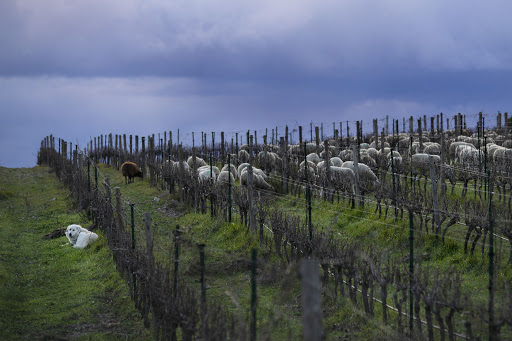Integrating animals in vineyards

Vineyards can be adequately grazed by ruminants to reduce the use of herbicides or mechanical weeding, improve soil fertility and prevent soil erosion. Grazing animals are generally sheep, but experiences exist with cows, goats and poultry. The choice of animals depends on the vine architecture -gobelet being more suitable for cows, others being necessarily with ewes or goats to allow circulation between rows. Some experiences exist with small animal breeds (e.g. Ouessant sheep breed) to allow grazing during vegetative season but are not the most frequent. The choice of rustic animal breed can be also determinant to graze on poor soils and feed harsh vegetation.
The benefits for wine growers is to allow managing grass cover in winter without herbicides or mechanical weeding, reducing the risk of soil erosion that may be caused by too frequent ploughing. The animals’ dejections fertilize the soil increasing organic matter content, which can in turn increase water retention. Grazing also diversifies the plot flora, possibly reducing the competition of weeds with vine.
This practice is gaining interest in many wine growing areas in France and all around the world. The scope of technical and ecological benefits, and conditions for success are being documented.
Technical management risks such as breaking woods or soil compaction appear more as mental brakes, not confirmed in any report nor by practitioners, if management practices are adequate. Period and duration of grazing must be calibrated considering soil structure, climate, type and weight of animals.
Author: Marc Moraine (INRAE)
References:
Niles, M.T., Garrett, R.D. & Walsh, D. (2018) Ecological and economic benefits of integrating sheep into viticulture production. Agron Sustain Dev 38:1. doi.org/10.1007/s13593-017-0478-y
Moraine M., Ryschawy J., Napoléone M., Ramonteu S., Choisis J.-P., 2020. Complémentarités culture – élevage à l’échelle territoire : facteurs de déverrouillage et de pérennisation des projets collectifs. Innovations Agronomiques, 80, 99-112.
Tanquerel L., 2018. Opportunités et modalités d’un pâturage ovin au sein du domaine Les Clos de Paulilles. Mémoire de Licence GENA, Montpellier SupAgro-Antenne Florac, Université Paul Valéry 3.
Thiébaut V., 2017. « Caractérisation de la flore spontanée dans des vignes et proposition de semis d’enherbement pour permettre le pâturage de moutons en automne/hiver et pour rendre des services écosystémiques tels que limiter l’érosion et la lixiviation ». Rapport de stage 2ème année Montpellier SupAgro. 112 p.
CERPAM, 2017 [plaquette de présentation]. « Le pâturage des vignes en Provence : Un atout agroécologique pour la viticulture et l’élevage pastoral ». 2 p.
Chambre d’agriculture du Gard, 2017. « Guide pratique du pâturage des ovins dans les vignes. ». 2 p.
Relations
- Network
- List
- Geolocation
- More
INNOVATION Joint Research Unit
l'UMR Innovation vise à produire des connaissances et contribuer aux débats scientifiques et sociétaux sur les processus d’innovation qui participent aux transformations des systèmes agricoles et alimentaires, face aux enjeux globaux, dont le changement climatique
